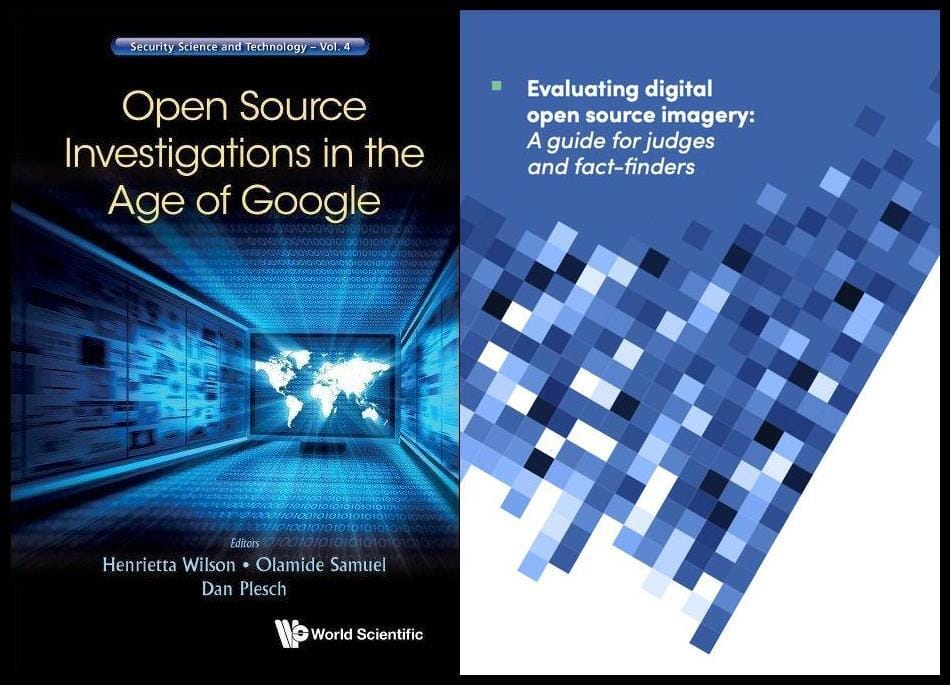
Investigators have two new, free books to help guide open source research.
In April, the Center for Strategic and International Studies released “Open Source Investigations in the Age of Google.” From a description of the book:
This interdisciplinary book presents 18 original chapters by prize-winning practitioners, experts, and rising stars, detailing what open source investigations are and how they are carried out, and examining the opportunities and challenges they present to global transparency, accountability and justice. It is essential reading for current and future digital investigators, journalists, and scholars of global governance, international relations and humanitarian law, as well as anyone interested in the possibilities and dangers of this new field.
They also hosted a video launch event:
In May, the TRUE project published “Evaluating digital open source imagery: A guide for judges and fact-finders.”
It’s lighter on OSINT techniques and is more focused on helping “judges and other decision makers in their assessment of open source information, by explaining some of the most common open source investigative techniques.”
It’s great to see more freely accessible resources! The CSIS and TRUE publications join two other books/series:
The Verification Handbook series from the European Journalism Centre, which has three editions, the most recent of which came out in 2020. I edit the series and we’re working on securing funding for a fourth edition. We hope to have news soon. (If you’re interested in helping with funding, please reach out!)
The Global Investigative Journalism Network’s Reporter’s Guide to Investigating Digital Threats.
Tools
📍 Leap AI has a tool that’s lets you enter an email address and receive a basic summary of online links and details about the person behind it. It also has a tool to detect if text was generated by AI. Evergreen warning: never rely solely on an AI detection tool!
📍 Copyleaks also has a tool to detect AI-generated text, among other things. (Same warning!)
📍 Google launched a search filter that restricts results to text-based links.
📍 ScrapeGraphAI is an AI-powered webscraper available on Hugging Face. There’s also now a community for journalists on Hugging Face. (via @fdaudens)
📍 OSINT Framework was updated with new tools.
📍 The Open Source Munitions Portal added nine new features, including location/date search, analyst notes, and edit history.
📍 Darkus is a dark web meta search engine. (via The OSINT Newsletter)
📍 Browser.lol is a virtual browser you can run in a regular browser. (via Cyb_detective)
📍 YouTube Trending Videos Research is a free tool that displays popular videos by country and language. (via Cyb_detective)
📍 CloudFlare Resolver is a free tool to see if a domain protected by CloudFlare has subdomains that do not use the service. (via Cyb_detective)
📍 ExportGram is a tool that lets you export 100 instagram comments for free.
📍 Shadow Finder is a tool from Bellingcat that you can use to “estimate the points on the Earth's surface where a shadow of a particular length could occur, for geolocation purposes.” Check out this video to see how it works.
📍 OnChain.industries is a new blockchain wallet search tool.
Webinars worth attending
🖥️ Investigative Journalism for Europe is offering a series of free webinars that go “behind the scenes of ambitious cross-border investigations in the public interest.” Topics include gold mining in the Amazon, Russia’s drone war in Ukraine, and Europe’s bear crisis.
Worth watching
“How 'open-source' journalism transformed investigations at the BBC”
Worth reading
📚 Alexios Mantzarlis, a former fact checker and Google employee who now leads the Security, Trust & Safety Initiative at Cornell Tech, launched a weekly newsletter called Faked Up. He highlights research and reporting about falsehoods and their harmful consequences.
📚 Alexa van Sickle wrote, “Tipsheet: Latest Tools for Investigating with Telegram.”
📚 Gretel Kahn wrote, “How Generative AI Is Helping Fact-Checkers Flag Election Disinformation, But Is Less Useful in the Global South”
📚 Matt0177 wrote, “Leveling Up Your OSINT Game: Creating a Professional Email on a Budget” (via )
📚 Sofia Santos wrote, “Embracing failure: The Importance of making mistakes in OSINT” (via Sector305’s Week in OSINT). She also gave a talk about “Getting started in open source research,” which you can listen to here.
📚 Jonathan Theuring and Katie Barnard wrote, “Bing vs Google: Search Engine Comparison 2024” (via Jess B and The OSINT Newsletter)
📚 Predicta Lab wrote, “GEOINT: Using Overpass Turbo for OSINT”
📚 Benjamin Strick wrote, “Geolocating a Gang Leader Wanted by the FBI: An OSINT Explainer”
📚 Pooja Chaudhuri wrote, “How Four Hindu Nationalist Websites Make Their Money”
📚 The Humber College StoryLab published, “Using OCCRP’s Aleph for Dark Web Data Analysis.”
📚 Henk Van Ess wrote, “Dissecting Propaganda: how AI Can Cut Through North Korean TV Spin”
📚 Negar Kamali, Karyn Nakamura et al. wrote, “How to Distinguish AI-Generated Images from Authentic Photographs”

